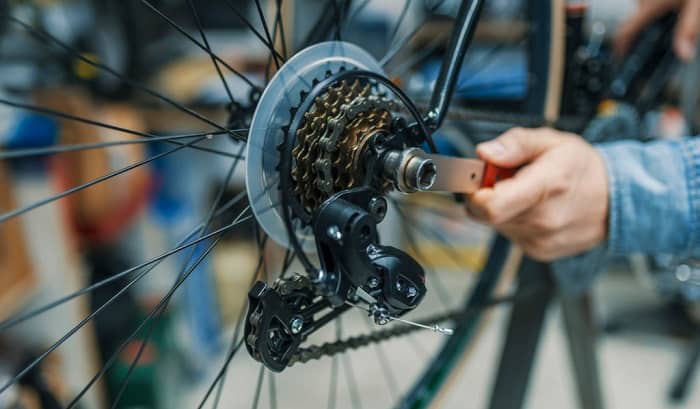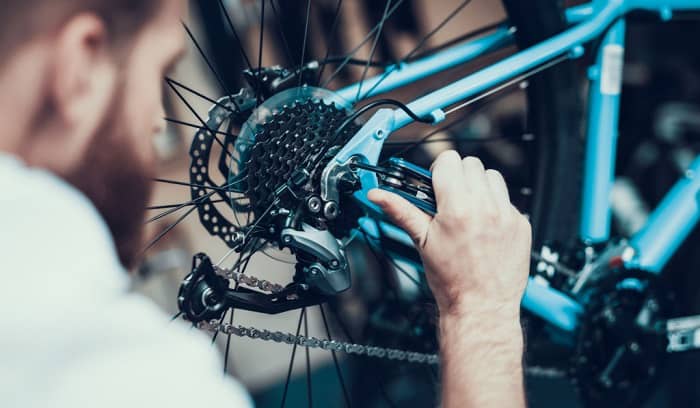A bicycle derailleur is a crucial component of a cycling machine. It directly impacts the speed and the covering distance of a rider. It is a guiding mechanism that allows cyclists to change chains from one sprocket to another.
Derailleur helps the chain convert the energy released by the cyclists when pedaling. It modulates this input and transfers it to an ideal output manifested through distance and speed. Both front derailleur and bicycle rear derailleur work using the same principle. Therefore, it is important to understand their functionality in order to know the overall workings of a bicycle.
How does a rear derailleur work? Let’s find out by reading this guide below.
Table of Contents
The Basic Function of Bike Derailleurs
Derailleurs are crucial parts of a bicycle gearing system. They usually come with a chain, sprockets, and an entire mechanism that helps move the chain from one sprocket to another. Derailleurs are basically sprockets that are normally triggered by the amount of energy received from pedaling. The sprocket located at the rear wheel is called rear derailleurs.
What is a rear derailleur? The bicycle rear derailleur has two basic functions – keep the chain tense and switch gears. It is intentionally positioned in an area where the chain slacks from time to time. The derailleur is often called the chain tensioner because of this specific task.
Keeping the chain tense
In order to keep the chain tense, the derailleur normally adjusts its placement to maintain tension in the chain regardless of the gear you are using. The derailleur will move based on where the chain goes. The chain may move to the biggest sprocket or to the smallest sprocket depending on the gear used.
Once the chain moves to the biggest sprocket, the rear derailleur lessens the tension since the chain is wrapped around the sprockets. In case the chain goes to the smallest sprocket, the derailleur will increase the tension because the chain slacks in this position. The function of the derailleur is to balance the tension on the chain.
Switching gears
Another function of the derailleurs is to shift gears. The derailleur helps cyclists change gears by moving the bottom of the chain from one side to another side. The rear derailleur changes when you pedal the bike and brings tension to the bike chain. When this happens, the force from the front sprockets will be transferred to the rear sprockets. This creates too much tension where the rear derailleur needs to balance. To do this, the derailleur will move the chain to another sprocket, especially when you are pedaling hard.
Components of Rear Derailleurs
Since a rear derailleur is an integral part of your bicycle, it is vital to know the different parts of the rear derailleur and how they work. Bike rear derailleurs are broken down into various parts that have specific functions, as well:
1. Construction
Normally, a rear derailleur is located below the rear cassette and is properly attached to the bike chassis using a bracket. There is a mounting bolt that secures the derailleurs to the bike onto the bike frame’s derailleur hanger.
The cassette comes with a spring-loaded linkage mechanism that is commonly referred to as the parallelogram. You will notice that this linkage mechanism has a cage that boards two pulleys. They are called the jockey pulley or guide pulley or ‘G’ pulley (top) and the tension pulley pr ‘T’ pulley (bottom).
These pulleys play a very essential role in the tensioning system of the chain. The top pulley is responsible for driving the chain from one sprocket to another. On the other side, the tension pulley’s main function is to take up chain slack and provide the right tension in the process. It ensures that there is enough tension between the driving and the driven sprockets.
2. Process
The components mentioned above are triggered by a cable aligned to a shifting toggle. When you use the toggle, the cable will either tighten, slacken, or be kept in place. When this happens, the parallelogram linkage will move along with a diagonal axis and bring the cage and the pulley with the movement.
When the cage moves, the ‘G’ pulley or guide pulley will be brought in the direction of the desired sprocket. It will also adjust the tension in the chain whether the pulley adds or reduces the tension.
Typically, when you shift to lower gears, the chain will be automatically transferred into the bigger sprockets. The bike derailleur during this process will move inwards and upwards as it follows the command of the chain, and goes to the selected sprocket. Once the tension increases in the chain, observe that the ‘T’ pulley goes away from the ‘G’ pulley.
3. Indexing
Indexing is another important process for the derailleurs. It is the derailleur moves as triggered by the cable toggling. Indexing is a crucial process that allows for smooth and seamless shifting of your bike gears.
Normally, your bike derailleur is connected to a shift lever using a cable that passes through the housing. Indexed shifters allow the movement of the cable with every click. The shifters work with barrel adjuster and are found either in the derailleur body or in the shift lever. These adjusters are used to ensure that shifting runs smoothly in between cogs.
Hence, it is vital to have a properly indexed derailleur to prevent the chain from falling between sprockets or driving crooked. When this happens, the chain will get damaged, as well as the cassette.
4. Limit Screws
The part that prevents a derailleur from extreme movement is the limit screws. Basically, derailleurs come with limit screws and adjust rear derailleurs by preventing them from going to their extremities. Limit screws restrain the derailleur from shifting too far in both inward and outward directions.
Conclusion
Mountain bikes require an efficient and reliable front and rear derailleur in order to function more effectively. The bicycle rear derailleur works as a chain tensioner by shifting from smaller sprockets to the bigger sprocket. It is in this process that your bicycle moves seamlessly without putting too much tension on the bike chain. Without derailleurs, you might end up damaging the chain, and putting too much effort into pedaling.
Hope you this article on how does a rear derailleur work usefull. Please like and share this guide if you like it.

“I ride my bike to work for years, but is that enough? Our carelessness towards our surroundings has taken a toll on the environment. And now, everyone is responsible for changes; even the most minor contribution is counted. With this hope and spirit, I started with my partner to establish Biketoworkday to help more individuals commute to their work sites on their bikes.”



